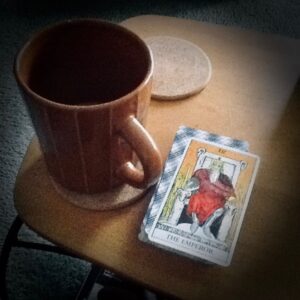 In learning about the Thoth deck, I’ve been reading a lot of information about Crowley and the Hermetic Order of the Golden Dawn. One of the sources mentioned that although some of the members wrote extensively about using the Tarot for divination, the group was far more likely to use the cards for meditation. I have to admit that this surprised me, and it took me a bit to conceptualize what it might mean.
In learning about the Thoth deck, I’ve been reading a lot of information about Crowley and the Hermetic Order of the Golden Dawn. One of the sources mentioned that although some of the members wrote extensively about using the Tarot for divination, the group was far more likely to use the cards for meditation. I have to admit that this surprised me, and it took me a bit to conceptualize what it might mean.
If someone were to ask me how I use the cards, the word “meditation” might not even come up. I would probably mention that the cards are an excellent tool for problem solving and creative thinking. I might also speak about how the cards can be used when seeking guidance and direction, and how they are a powerful tool to help us get in touch with our needs and priorities. Meditation? Maybe, but it wouldn’t necessarily occur to me, and it certainly wouldn’t be first in my mind.
Yet, when I look at the main ways that I have used the Tarot cards, from the very beginning, they have been very close to what might be called “mindfulness practice.”
There are many different ways to use the cards in meditation. I’ve seen sets of guided meditation recordings available for the entire Major Arcana. Some folks like to place a card on display and focus on it in the same way that one might use an icon or murti or candle. My own practice is that of simple reflection and contemplation.
When you read any of the longer essays in my Daily Draw archives, you’re seeing the results of a Tarot meditation. I usually do my card draw early in the morning, most of the time after my other morning spiritual practices. I shuffle the cards, hold the deck in my hand for a few moments to get my mind quiet, and then cut it in the middle and turn over the card. I observe any initial reactions, and begin to reflect on what meaning the card may have for me in the context of the day. Does it relate to anything that has occurred in my life recently, or to any of the scripture readings of the morning, or to any plans that I have for the day?
I post a photo of the card to Instagram before much further consideration, usually adding only a phrase or a short sentence to the post.
Then, after a short time of reflection, I may begin to jot down a few brief thoughts, or I may take a look at some reference material about the card, and write a longer journal entry or essay. I’m always sure to document at least a few thoughts in an Evernote that has been set up specifically for my daily card draws for the season.
That’s essentially my practice.
If you’d like to take up something similar, here is what I would suggest.
Time and Place – If you are planning to create the habit of a daily Tarot Meditation, select a specific time (and perhaps a specific place) for your card draws. It will much more likely become a routine – and will yield more benefits – if you do. I find that unless I feel like writing a longer reflection on a particular card draw, this practice takes only five or ten minutes each day.
Pre-Draw Ritual – Use some sort of ritual in the way that you approach the draw. This will help to get you in the optimal frame of mind for reflection.
Observe Your First Reaction – Be sure to pay attention to your first intuitive reactions and impressions when you turn the card up. Make note of anything that “pops into your mind” however random and unrelated it may seem.
Keep a Journal – Create some formal record of each session. You might keep a notebook handy where you can record the date of the draw, the card drawn, and your thoughts about it. It can be as simple as a pad of paper and a pen, or as elaborate as you want to make it. I have kept a series of Evernotes (one for each season of the year) with photographs and notes every day for more than two years now. I don’t share these notes with anyone else, so I can feel free to write whatever is in my head, no matter how disjointed or frightening. 🙂
I do, also, share some thoughts publicly here on the weblog as well when I feel that it’s appropriate. So it’s alright to share the results of your Tarot meditations with others if you’d like, but don’t feel as if that is necessary. You’ll want to have some place to note things down that feels entirely safe for you to write whatever occurs to you without inhibition. Looking back at your journal entries over time, you may be surprised at how the cards have helped to bring the work of grace into your life.
A Few Links – Here are some other articles on this subject that I enjoyed.
7 Steps To Developing Your Intuition With Tarot Meditation – Biddy Tarot
Other Uses for the Tarot: Meditation – Llewellyn
Yoga and Tarot Cards: How One Month of Pulling a Tarot Card Every Day Transformed My Practice – Yoga Journal
I hope that this information is helpful to you. I’d love to hear from you with questions or your own ideas and observations. Leave a comment!